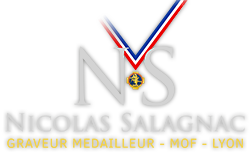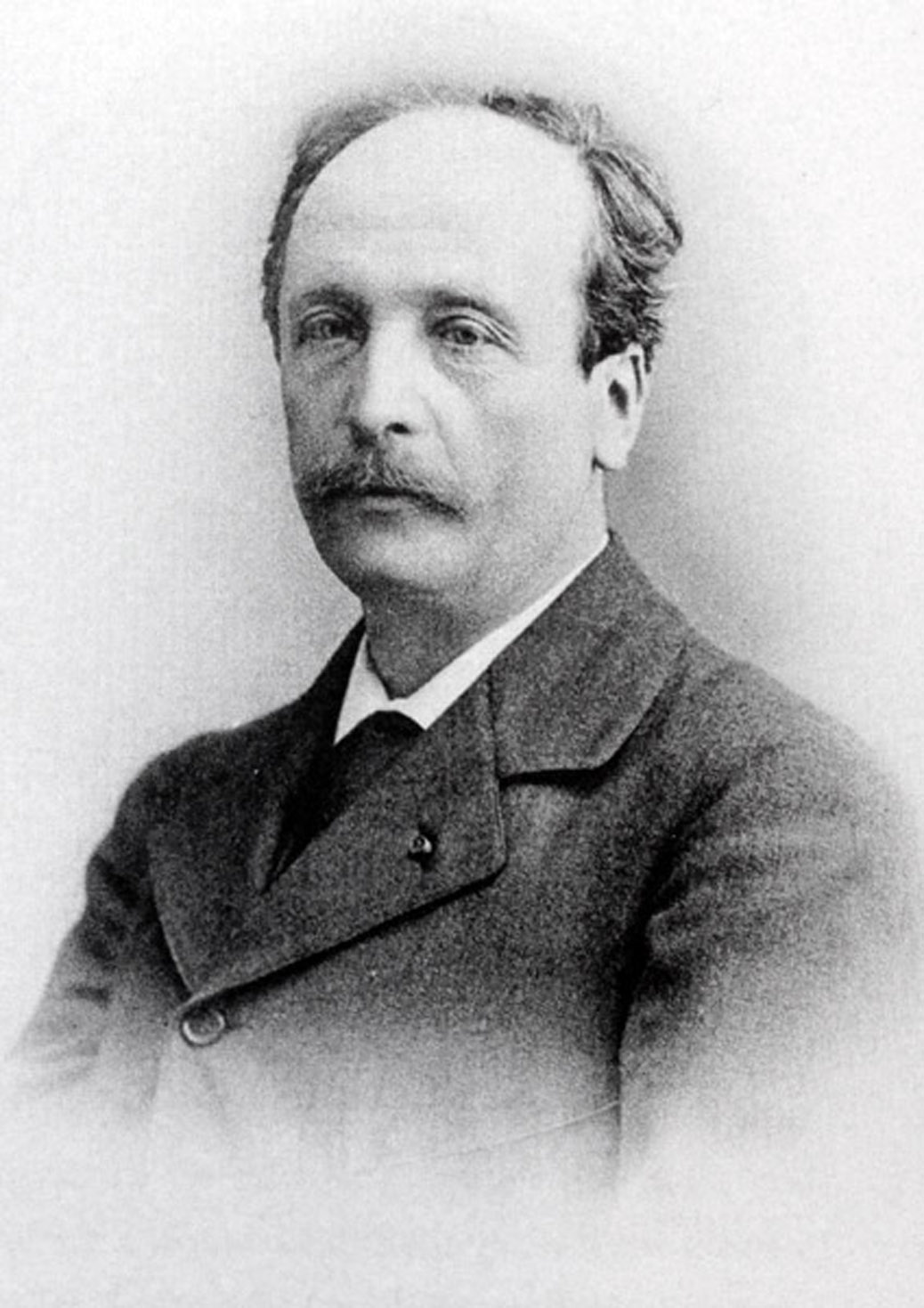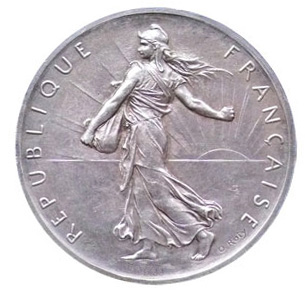 Louis Oscar Roty is a French coin and medal engraver. He was born in Paris on 11 June 1846 and died in Paris on 23 March 1911.
Louis Oscar Roty is a French coin and medal engraver. He was born in Paris on 11 June 1846 and died in Paris on 23 March 1911.
He is the creator and engraver of the famous currency that marked the 20th century: the so-called « Semeuse » of Roty, universally known. The popularity of this monetary model prompted the Post Office to ask Roty to adapt the stamp.
In 1875, he obtained the first great prize from Rome.
In 1888, he was received at the Paris Academy of Fine Arts.
In 1889, he won the Grand Prix at the Universal Exhibition.
He leaves a considerable and remarkable work, with delicate models full of clarity and light, with very pure lines.
I particularly like his work, the purity of his compositions and especially his very delicate and subtle drapes.
I do not develop his biography any further, but refer to a beautiful well documented article « Louis Oscar Roty (1846-1911) – Un graveur dans la République » by Pierre Chantereau, Curator of the Oscar Roty Museum: Link.
Below, image and text of Rida Roty, information on page FB: La Semeuse de Roty.
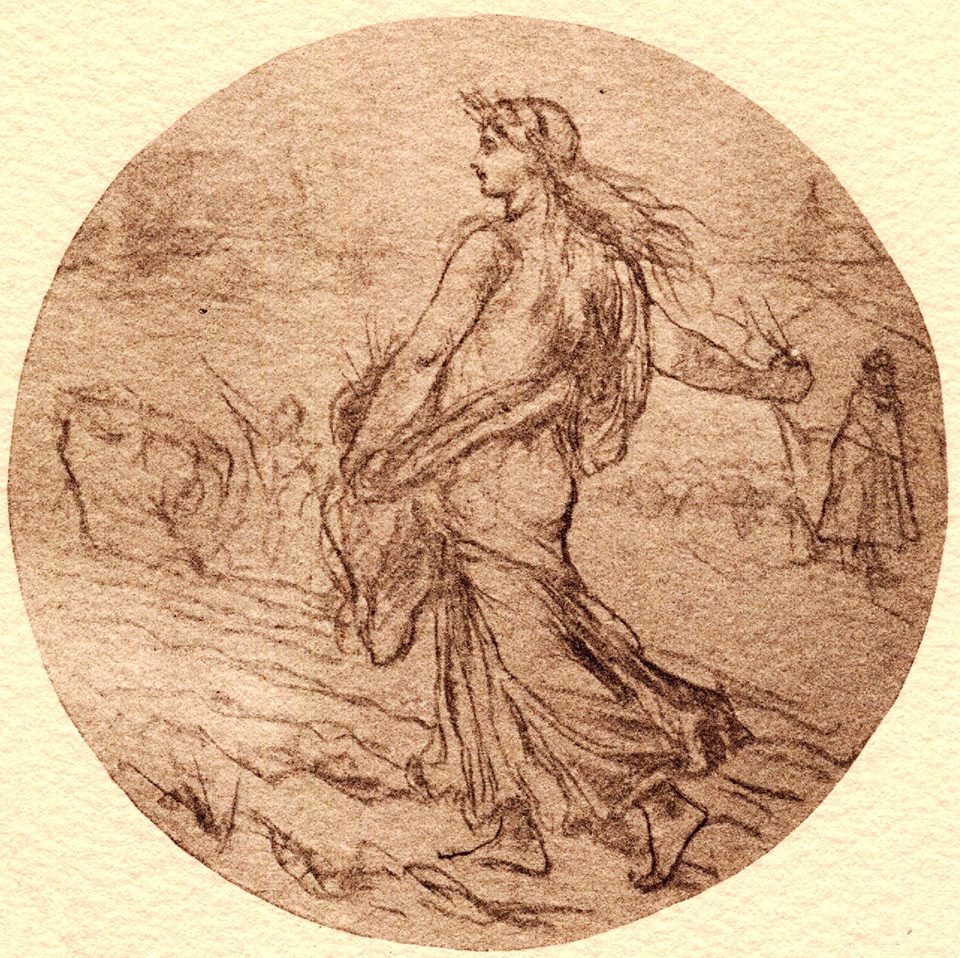 First charcoal sketch of the Sower originally planned for a competition project of the Ministry of Agriculture in 1886.
First charcoal sketch of the Sower originally planned for a competition project of the Ministry of Agriculture in 1886.
When Roty learned that his master Ponscarme was a candidate in the same competition, he had the elegance to retire so as not to find himself in competition with him. His project then slept in his workshop until 1895 when Finance Minister Paul Doumer wishing to create a new monetary series called upon him for silver money.
One will note the absence of sun and Phrygian cap and the presence of scenes of ploughing.
(Drawing from the book : Le médailleur Louis-Oscar Roty, Sa vie, son œuvre, Georges Roty, Presses du Compagnonnage, 1971).
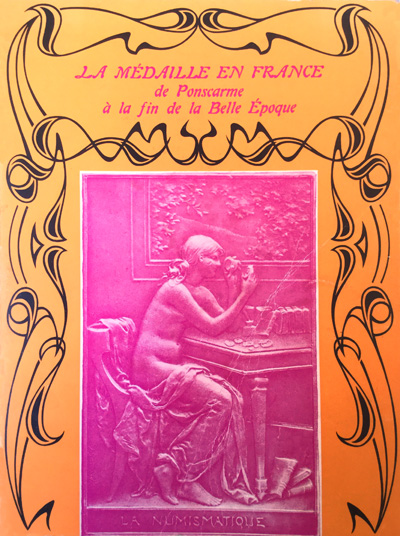 Supplement from the magazine : « La médaille en France – de Ponscarme à la fin de la Belle Époque » – exhibition Hôtel de la Monnaie – June to September 1967.
Supplement from the magazine : « La médaille en France – de Ponscarme à la fin de la Belle Époque » – exhibition Hôtel de la Monnaie – June to September 1967.
LOUIS-OSCAR ROTY
Born in 1846 and died in 1911 in Paris.
He first attended Lecoq de Boisbaudran’s drawing classes at the Arts Décoratifs, then entered the Ecole des Beaux-Arts in 1864, where he was a student of Ponscarme. Received the First Grand Prix of Rome from engraving in medals in 1875 for a wax model representing « A shepherd trying to read the inscription engraved on a rock of the passage of Thermopylae », which was then engraved in hollow on steel. Roty stayed three years in Rome from where he sent in particular the model of his medal « Art applied to industry ». He exhibited in the various Salons and won the great prize at the Universal Exhibition of 1889. He entered the Academy of Fine Arts on 30 June 1888. Since the beginning of the century, medal engraving has only been represented at the Institute by one artist. It was on Chaplin’s initiative that Roty’s former position was restored. Apart from the medals, Roty performed only two bas-reliefs: « La Peinture » and « La Musique », for window tympans at the Hôtel de Ville in Paris. He made a commemorative plaque for the visit of the Russian sovereigns to Versailles in 1896. His medals to commemorate family events had an extraordinary vogue. It was he who executed the models of silver coins the effigy of the Sower (1897). Finally, supreme honour, in 1905, he received the medal of sculpture at the Salon awarded, for the first time, to engraving in medals. He was the one who honoured the platelets and introduced the landscape into the medal. He attaches extreme importance to the inscriptions of his medals; although he is not a Latinist, he knows how to choose the most appropriate terms and has them translated by his friends from great cultures.
Roty also expressed his conception of the medalist’s work: « Our mission in art is admirable. We note the good and the bad done, and today, widening our field, we belong, of its sufferings, its joys, its aspirations. »
834. ASSOCIATION FRANÇAISE POUR L’AVANCEMENT DES SCIENCES. 1872. Médaille bronze argentée. [68] [Appartient à la collection de M. Raymond Joly.]
835. ARTlBUS ET LIBERTATE FLORET PATRIA. 1873. Médaille bronze [50]
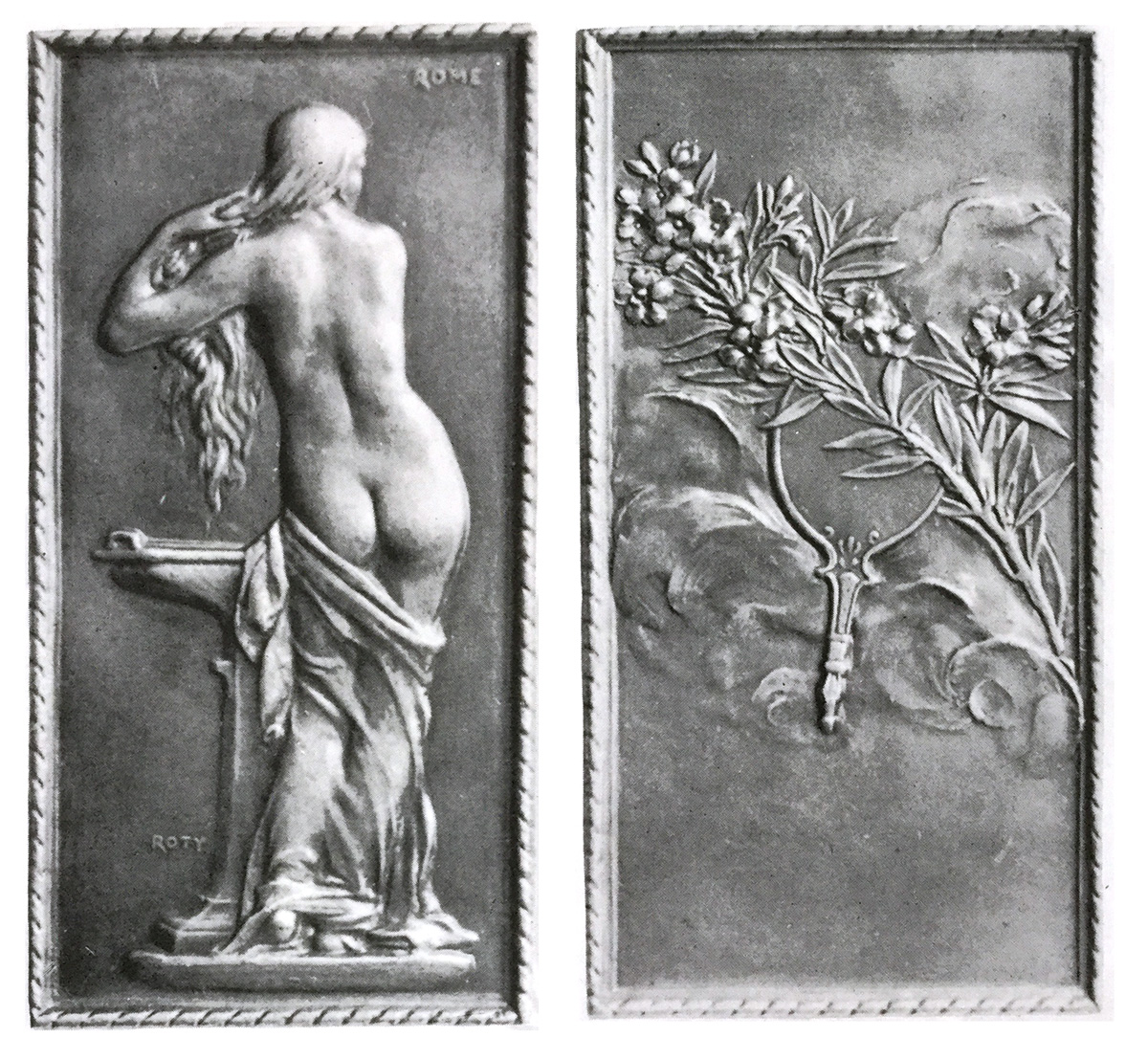 836. LA TOILETTE. 1879. Plaquette bronze [70 x 32]
836. LA TOILETTE. 1879. Plaquette bronze [70 x 32]
837. JEAN CHAZIÈRE. 1879. Plaquette bronze [70 x 40]
838. MENS AGITAT MOLEM, pour l’Union Centrale des Arts Décoratifs. 1880. Plaquette bronze [65 x 45]
839. MAISON L’ÉDUCATION POUR DES JEUNES FILLES À AUBERIVE (HAUTE-MARNE) . 1885. Médaille bronze. [45]
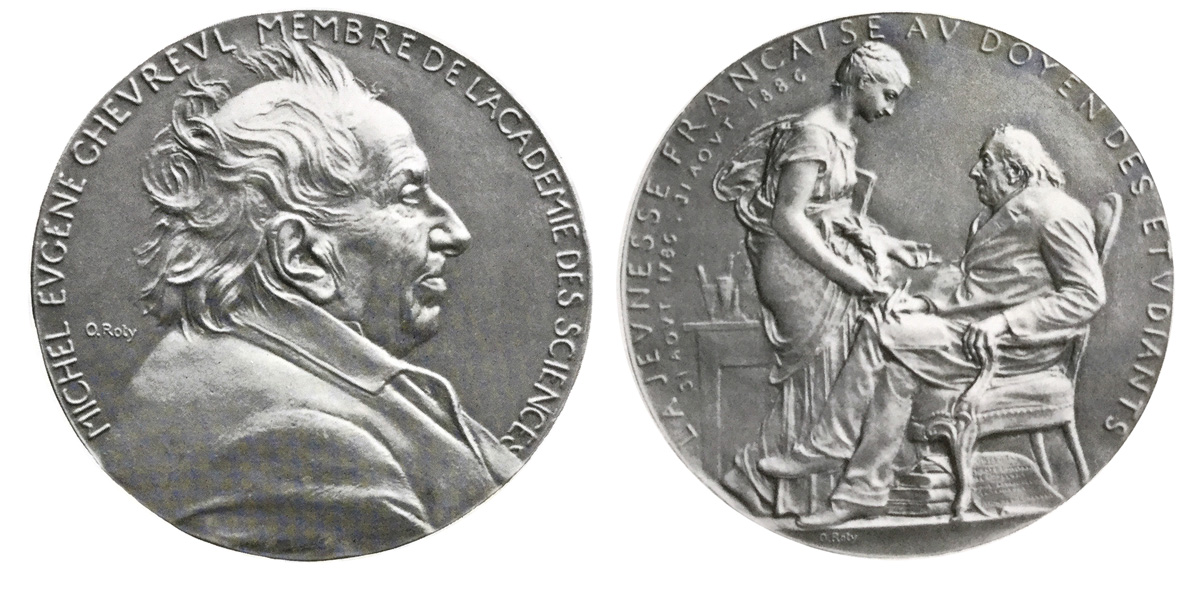 840. CENTENAIRE DE MICHEL CHEVREUL, MEMBRE DE L’ACADÉMIE DES SCIENCES. 1886. Médaille bronze [68]
840. CENTENAIRE DE MICHEL CHEVREUL, MEMBRE DE L’ACADÉMIE DES SCIENCES. 1886. Médaille bronze [68]
841. OUVERTURE DE LA LIGNE D’ALGER À CONSTANTINE. 1886. Médaille bronze [68]
842. LOUIS PASTEUR, pour l’Institut Pasteur. 1887. Médaille bronze [35]
843. GUSTAVE-ADOLPHE HIRN. 1889. Médaille fonte bronze [100]
844. CHAMBRE DE COMMERCE DE PARIS. Médaille bronze [50]
845. L’ÉPARGNE FRANÇAISE PRÉPARE LA PAIX DU MONDE, pour la Compagnie Universelle du Canal de Suez. 1889. Médaille bronze. [40]
846. FERMIÈRE. 1889. Médaille bronze [50]
847. AMICUS PLATO SED MAGIS AMICA VERITAS. 1889. Plaquette bronze. [60 x 45]
848. IN LABORE QUIES. 1890. Plaquette bronze. [50 x 52]
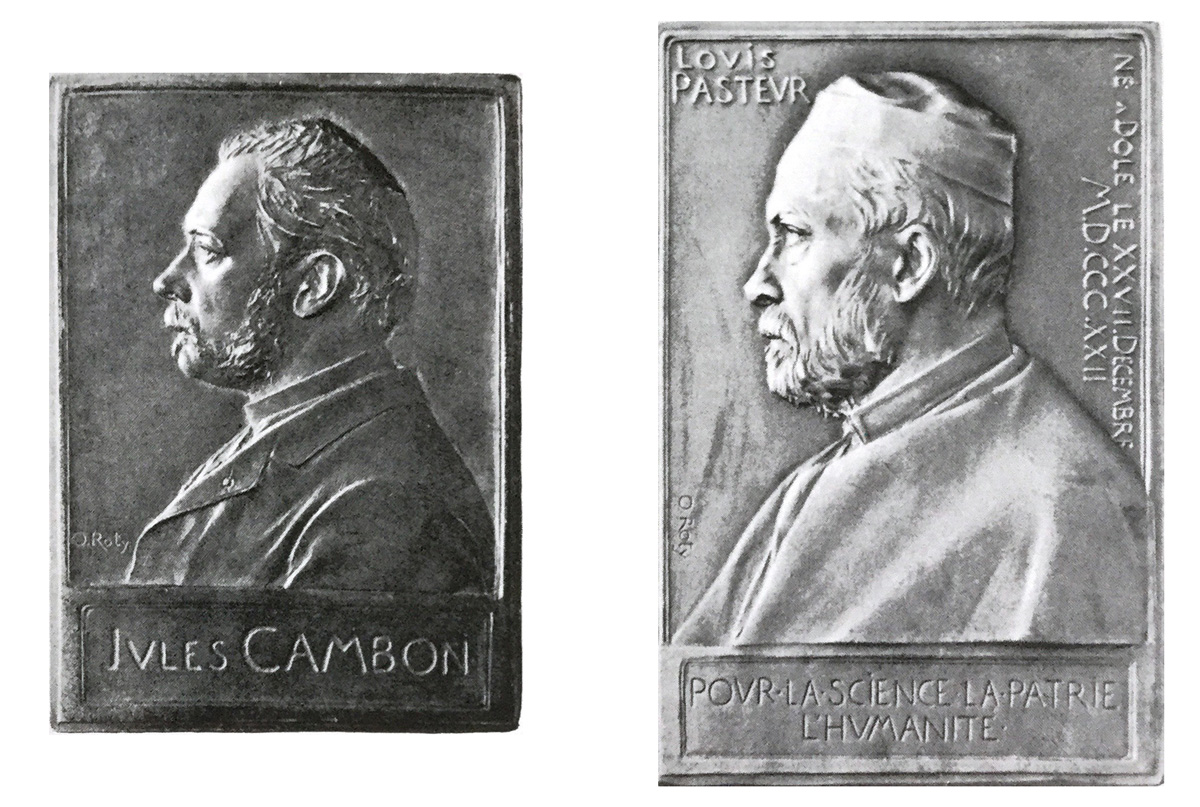 849. JULES CAMBON, PRÉFET DU RHÔNE. 1891. Plaquette bronze. [58 x 42]
849. JULES CAMBON, PRÉFET DU RHÔNE. 1891. Plaquette bronze. [58 x 42]
855. LOUIS PASTEUR LE JOUR DE SES SOIXANTE-DIX ANS. 1892. Plaquette argent pour la face et bronze pour le revers. [65 x 45]
850. JULIEN GIRARD, PROVISEUR DU LYCÉE CONDORCET. 1891. Plaquette bronze. [60 x 43]
851. MOSCOU ACCUEILLE LE GÉNIE FRANÇAIS, pour l’Exposition française à Moscou. 1891. Médaille bronze [62]
852. REGARDE, ÉCOUTE, VEILLE. 1892. Plaquette bronze. [58 x 43]. À la face, Henri Lozé, Préfet de Police.
853. JUBILÉ DE LA MAISON D’ORFÈVRERIE CHRISTOFLE. Plaquette bronze pour la face et argent pour le revers.
854. CHARLES CHRISTOFLE, fondateur de la maison. 1892. Plaquette bronze. [40 x 28]
855. LOUIS PASTEUR LE JOUR DE SES SOIXANTE-DIX ANS. 1892. Plaquette argent pour la face et bronze pour le revers. [65 x 45]
856. EXPOSITION INTERNATIONALE DE CHICAGO, Section FRANÇAISE. 1893. Plaquette bronze. [50 x 52]
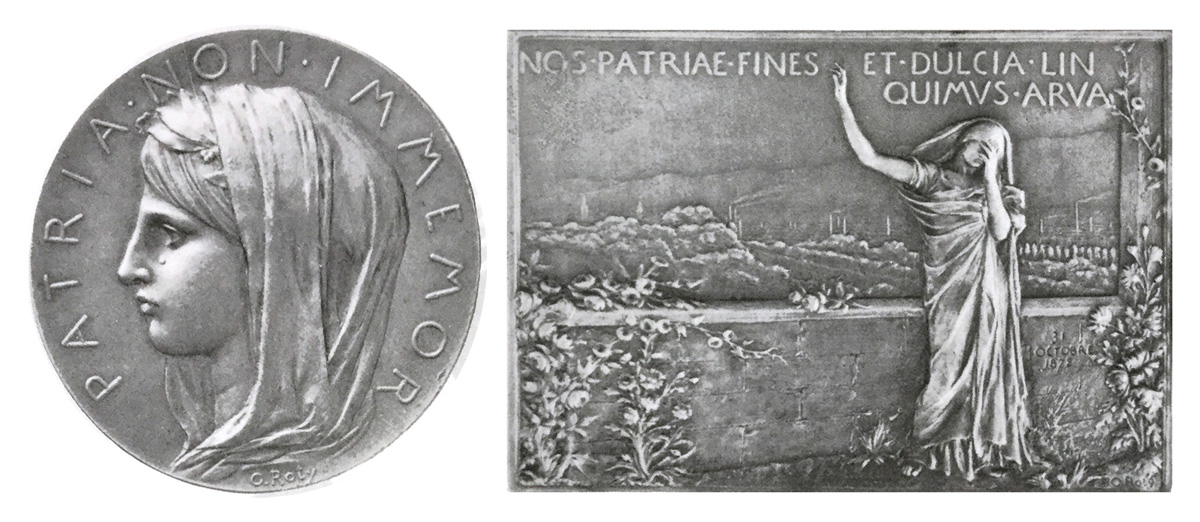 857. PATRIA NON IMMEMOR. 1893. Médaille bronze. [35]
857. PATRIA NON IMMEMOR. 1893. Médaille bronze. [35]
869. IN JUVENTUTE SALUS, pour les noces d’argent d’Alfred Engel et Catherine Kœchlin de Mulhouse. 1898. Plaquette bronze. [55 x 80]. Cette plaquette s’intitule aussi « Les Adieux » rappelant le départ d’Alsace, en 1872, de cette famille désireuse de rester française.
858. HIPPOLYTE-ADOLPHE TAINE. 1893. Plaquette bronze. [80 x 60]
859. GENEVIÈVE LOUIS, fille d’Hippolyte Taine. 1894. Plaquette bronze. [80 x 60
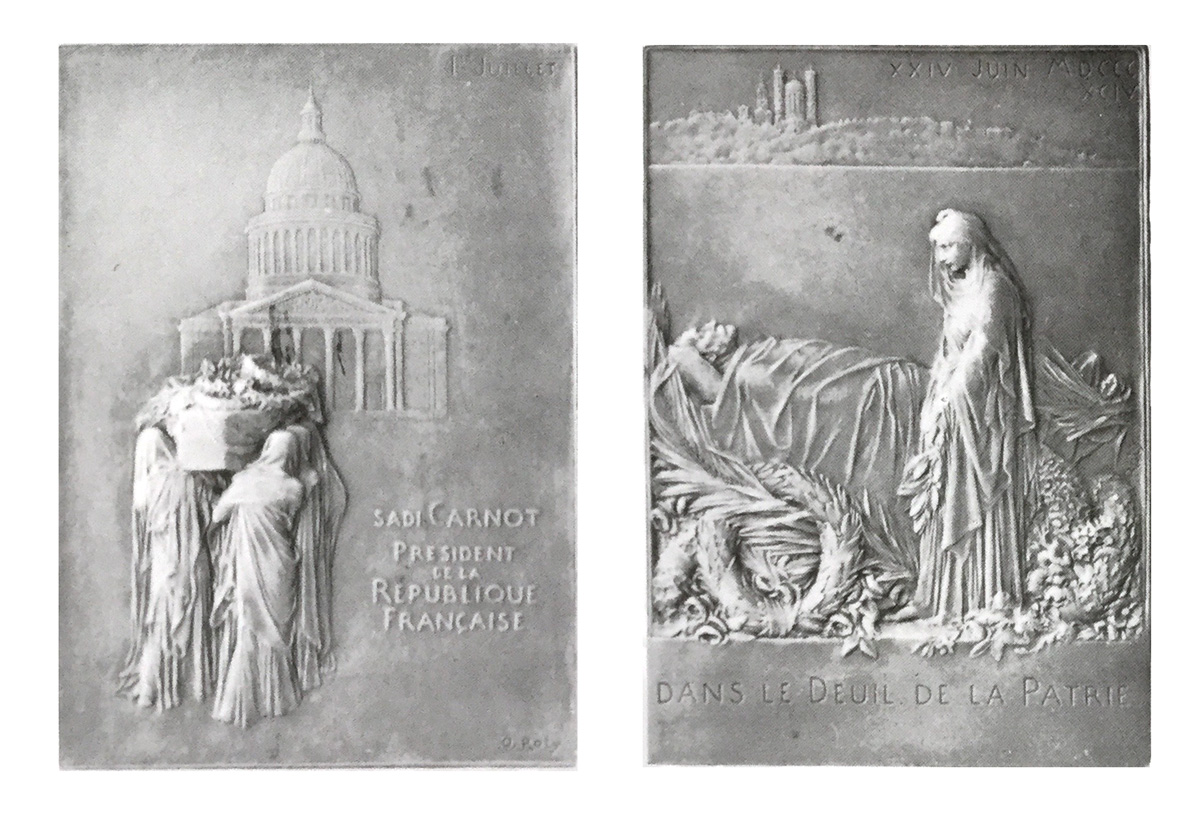 860. DANS LE DEUIL DE LA PATRIE. 1894. Plaquette bronze pour les funérailles du Président de la République Sadi Carnot. [80 x 55]
860. DANS LE DEUIL DE LA PATRIE. 1894. Plaquette bronze pour les funérailles du Président de la République Sadi Carnot. [80 x 55]
861. PER ARDUA, pour le Club Alpin français. Plaquette bronze. [60 x 45]
862. ÉMILE-GASTON BOUTMY, fondateur et directeur de l’École des Sciences Politiques. 1896. Plaquette bronze. [60 x 42]
863. VISITE DES SOUVERAINS RUSSES À VERSAILLES. 1896. Plaquette bronze. [60 x 42]
864. CHARLES PÉRIER, DE L’ACADÉMIE DE MÉDECINE. 1896. Plaquette bronze. [60 x 42]
865. NORMANNIA NUTRIX, Exposition Nationale ET COLONIALE DE ROUEN. 1896. Médaille bronze. [68]
866. SEMPER. 1897. Médaille de mariage. [40]
867. EDMOND ROUSSE, AVOCAT. 1897. Plaquette bronze. [60 x 43]
868. POUR LA SCIENCE, POUR LA PATRIE, pour le cinquantenaire de l’École française d’Athènes. 1898. Médaille bronze. [60]
869. IN JUVENTUTE SALUS, pour les noces d’argent d’Alfred Engel et Catherine Kœchlin de Mulhouse. 1898. Plaquette bronze. [55 x 80]. Cette plaquette s’intitule aussi « Les Adieux » rappelant le départ d’Alsace, en 1872, de cette famille désireuse de rester française.
870. LÉONARD DANEL, IMPRIMEUR. 1898. Médaille bronze. [50]
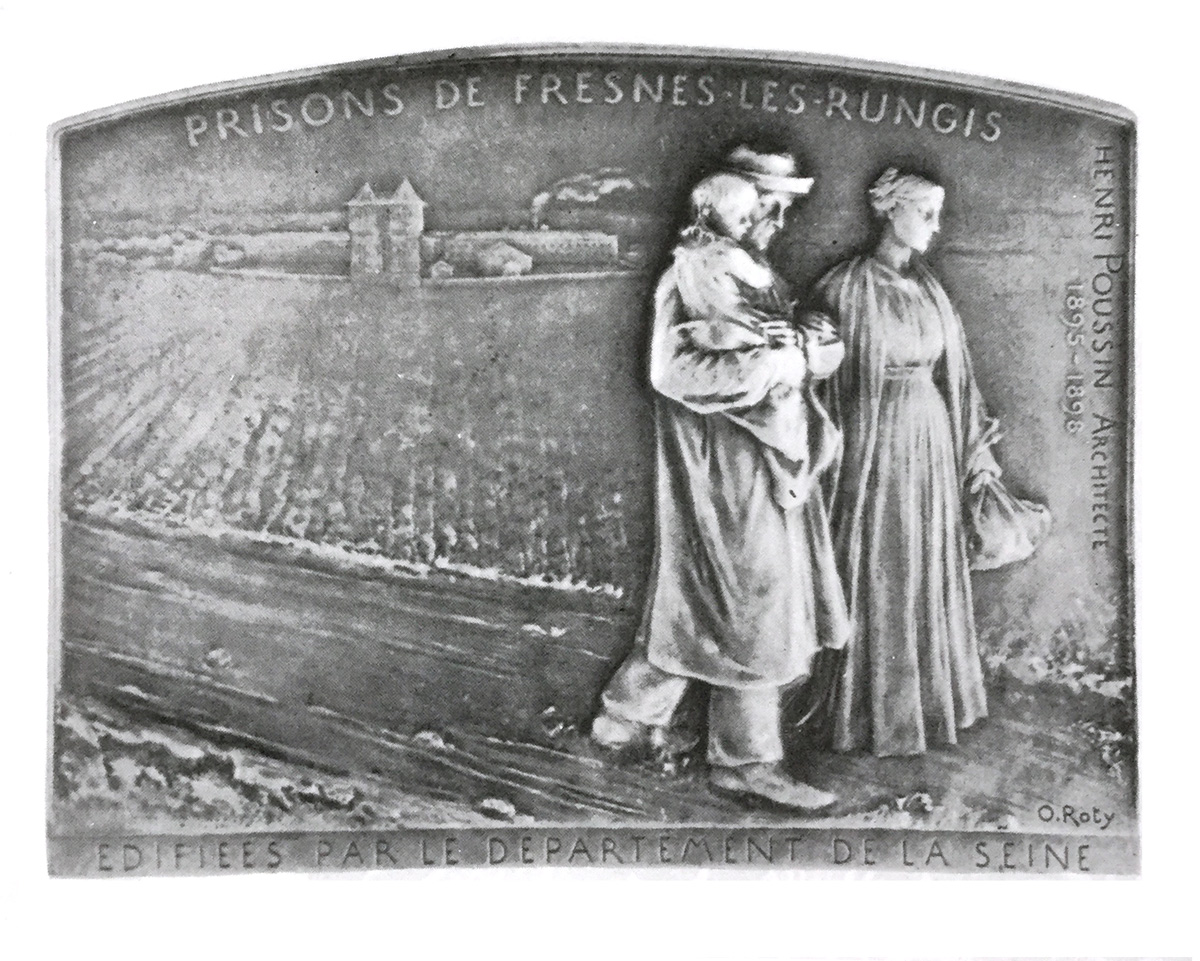 871. PRISONS DE FRESNES LES-RUNGIS ÉDIFÉES PAR LE DÉPARTEMENT DE LA SEINE. 1898. Plaquette bronze. [58 x 80]
871. PRISONS DE FRESNES LES-RUNGIS ÉDIFÉES PAR LE DÉPARTEMENT DE LA SEINE. 1898. Plaquette bronze. [58 x 80]
872. PRÉSERVER, RELEVER, SAUVER, AUX ÂMES BRISÉES SECOURS, pour l’Œuvre des libérées de Saint-Lazare. Plaquette bronze. [50 x 35]
873. NE DÉSESPÈRE PAS, pour l’Œuvre des libérées de Saint-Lazare. Médaille bronze. [45]
874. L’AMOUR CONSOLE L’HUMANITÉ. Plaquette bronze. [25 x 30]
875. MATERNITÉ. Plaquette bronze. [80 x 50]
876. VIGILAT ET VIGILABIT SEMPER. Plaquette bronze. [80 x 55]
877. RENDRE À L’HOMME PAR LE TRAVAIL LES RESSOURCES ENFOUIES DE LA NATURE, pour les Mines de Lens. 1899. Plaquette bronze. [67 x 47]
878. ALFRED RICHE, MEMBRE DE L’ACADÉMIE DE MÉDECINE. 1899. Plaquette bronze. [60 x 40]
879. NOCES D’ARGENT D’ENNEMOND MOREL ET ALBINE JOURNEL. 1900. Plaquette bronze. [65 x 74]
880. LUMEN VENTURIS TRADIT MORITURA PERENNE, pour l’Exposition Universelle Internationale de 1900. Plaquette bronze argenté. [50 x 35]. [Appartient à la collection de M. Raymond Joly.]
881. L.-H. FARABŒUF, PROFESSEUR D’ANATOMIE À LA FACULTÉ DE MÉDECINE. Plaquette bronze. [58 x 42]
882. Ô NYMPHE, LE VIN MARIANI VA LE SAUVER, MAIS PRENDS GARDE À TON CŒUR, pour le vin Mariani à la coca. Plaquette bronze. [50 x 37]
883. ANGELO MARIANI, vulgarisateur de la coca. Médaille bronze. [30]
884. VESTALE. Plaquette bronze. [50 x 30]
885. PIERRE SOYER. Plaquette bronze. [33 x 25]
886. JACQUES RAPHAËL LÉPINE, PROFESSEUR DE CLINIQUE MUSICALE. 1900. Plaquette bronze. [58 x 42]
887. ET MULTA ET MULTIS, pour le Congrès des valeurs mobilières. 1900. Plaquette bronze. [27 x 20]
888. MINISTÈRE DE L’INSTRUCTION PUBLIQUE. Médaille bronze. [50]
889. RÉPUBLIQUE FRANÇAISE. 1900. Médaille bronze. [50]
890. ÉMILE DEMAGNY, SECRÉTAIRE GÉNÉRAL DU MINISTÈRE DE L’INTÉRIEUR. Plaquette bronze. [60 x 38]
891. PAUL BROUARDEL, PROFESSEUR DE MÉDECINE LÉGALE. 1901. Plaquette bronze. [70 x 50]
892. ERNEST CRONIER, des raffineries Say. 1901. Plaquette bronze. [55 x 84]
893. GUSTAVE-LOUIS DUBAR, DIRECTEUR DE L’ÉCHO DU NORD. 1901. Plaquette bronze. [70 x 50]
894. MARIE LAURENT, DOYENNE DES ARTISTES DRAMATIQUES. 1901. Médaille bronze. [40]
895. JEANNE D’ARC : « VA, FILLE AU GRAND CŒUR ». Médaille bronze. [45]
896. JEANNE D’ARC : « MA MISSION ÉTAIT DE DIEU ». Médaille bronze. [45]
897. SAINTE GENEVIÈVE. Plaquette ovale argent. [45 x 35]
898. SAINTE GENEVIÈVE, PATRONNE DE PARIS ET DE LA FRANCE. Plaquette ovale argent. [45 x 35]
899. JOCKEY CLUB. Jeton octogonal argent. [ 26]
900. JULES LEFEBVRE, ARTISTE PEINTRE, MEMBRE DE L’INSTITUT. 1903. Plaquette bronze. [70X50].
Le plâtre et les médailles fondues suivantes nous ont été aimablement prêtés par M. Georges Roty, fils de l’artiste :
901. FEMME À SA TOILETTE, envoi de Rome, 1879. Plaquette. [210 x 110]
902. LA JEUNESSE FRANÇAISE AU DOYEN DES ÉTUDIANTS. 1886. [260]. C’est le revers de la médaille du centenaire de Chevreul.
903. PORTRAITS AFFRONTÉS DE SES PARENTS. 1886. Plaquette. [135 x 165]
904. REGARDE, ÉCOUTE ET VEILLE. 1892. Plaquette. [ 250 x 175]. C’est le revers de la médaille du Préfet de Police Lozé.
905. SEMEUSE, modèle du timbre-poste de 15 centimes. 1896. Plaquette plâtre. [200 x 170]
MONNAIES
906. 5 FRANCS 1898. Essai à la Semeuse. Avers : Sous un soleil levant, la République au bonnet phrygien, les cheveux au vent, ensemence de la main droite, la gauche soutenant la besace de grains. Revers : Au-dessus des branches de chêne, d’olivier, de coquelicots et d’épis 5 FRANCS. Argent. [37]
907. 2 FRANCS 1898. Même type. Argent. [27]
908. 1 FRANC 1898. Même type. Argent. [23]
909. 50 CENTIMES 1897. Même type. Argent. [18]
From a lecture given on Oscar Roty at the Musée Monétaire in February 1966 by Henri Dropsy, a member of the Institute, we extract these few lines summarizing his work:
Before Roty, Jean Duvivier and after him Mauger had been concerned with the picturesque truth, the true perspective and the values of the painting. This tendency will assert itself with Roty and the medal will become an intermediary between painting and sculpture. The subject will bind with the background, the distant ones will get lost in the mist and the reliefs will be moderate.
It would be necessary to quote all the portraits, all the profiles of rough and energetic men and all these women with graceful faces, all executed with a technique adequate to the subject and to his ideal; plan correctly and scrupulously arranged, impeccable form.
Roty’s art is made of clarity.
If all these men and women have so much character and truth, it is because Roty refused to make a portrait of chic, he wanted, if the model was alive, that he posed before him.
Shouldn’t we, between the features, make the soul glimpse, give the impression of life!
And it’s hard to make that up.
The work must be alive, sober, noble, while remaining truthful, must release a happy feeling of nature, a beautiful elevation of thought.
This beautiful elevation, this search, Roty seems to have devoted his life to it.
